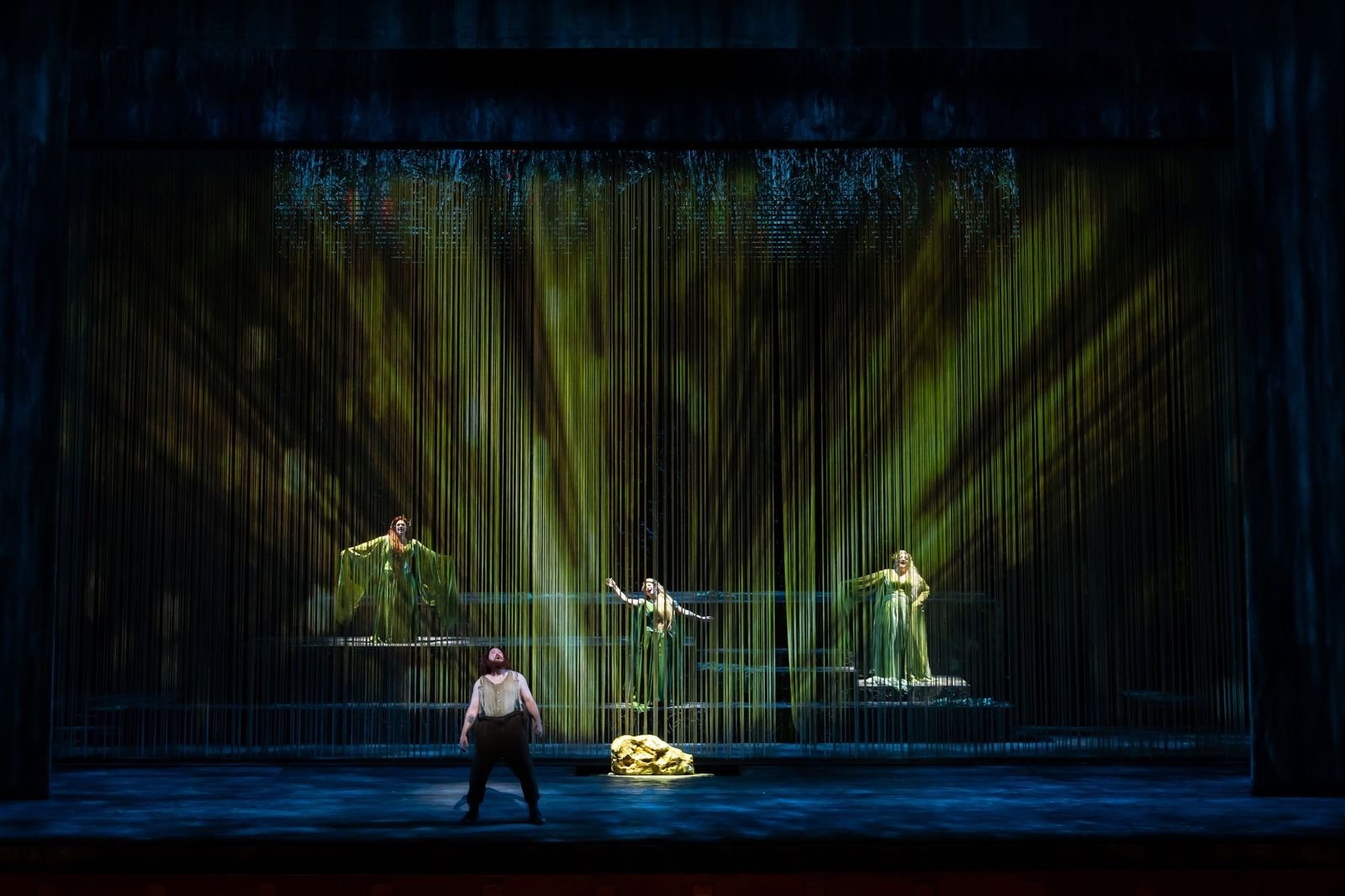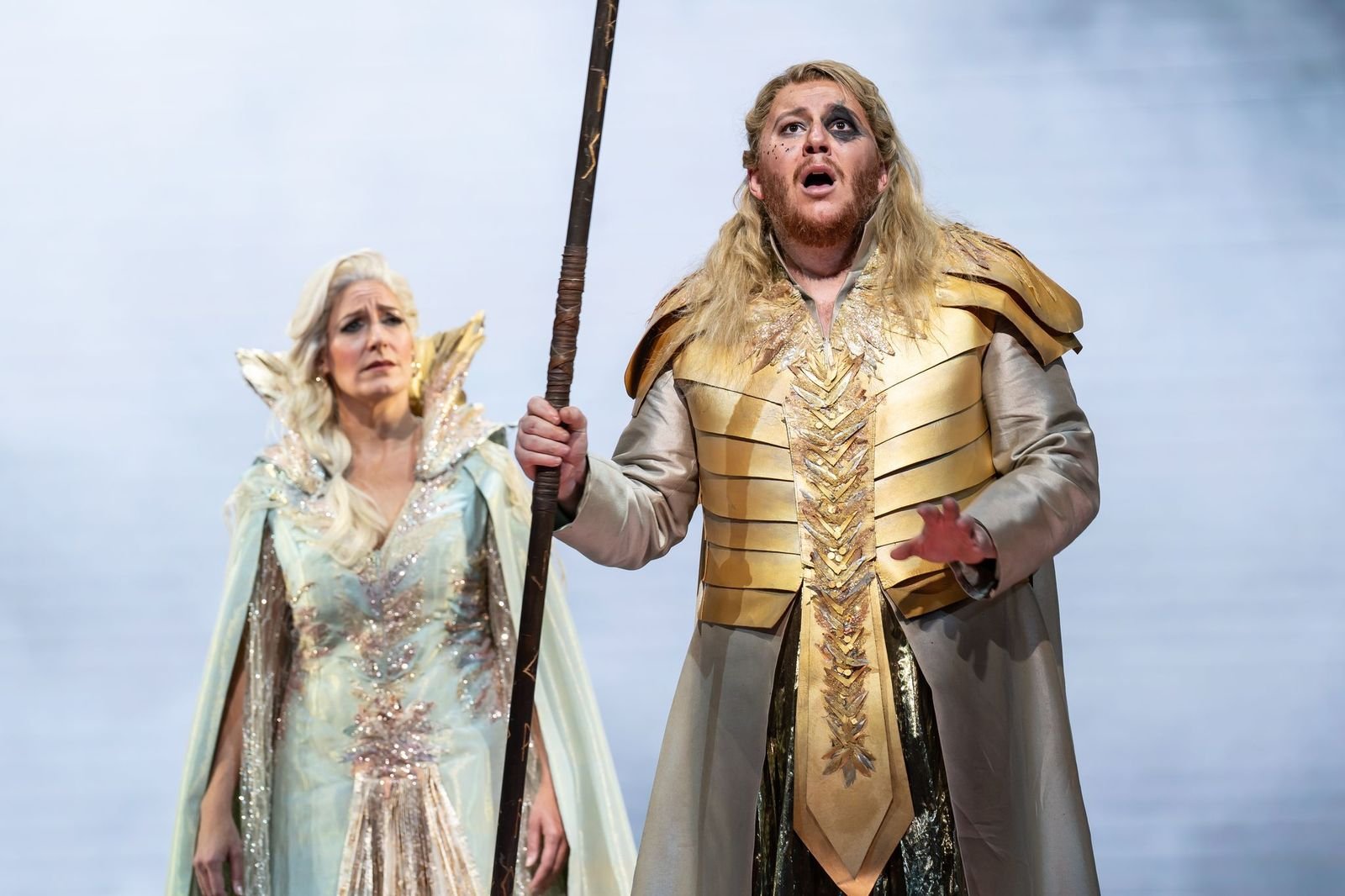Das Rheingold @ The Dallas Opera
Photos by Scott Suchman for The Dallas Opera
—Wayne Lee Gay
Superb singing and spectacular visual elements, firmly supported by conductor Emmanuel Villaume and the Dallas Opera Orchestra, resulted in an uproarious ovation at the close of The Dallas Opera's production of Wagner's Das Rheingold Friday night at Winspear Opera House.
The 150-minute long work, always presented without intermission, asks a level of audience devotion bordering on worship, and demands a level of excellence on stage and in the pit to merit that devotion. Norse mythology and the Norse pantheon form the basis of the narrative, played out by gods and demi-gods including Wotan, Fricka, Loge, and Erda in a world where Valhalla is new, and lust competes with idealistic heroism and devotion.
Late nineteenth-century European culture embraced Wagner's grand musical and dramatic ambitions; his harmonic and structural innovations dominated classical music for decades and changed the course of music well into the 20th century. But it was the rise and refinement of cinematic and digital technology in the later 20th century and early 21st century that now make possible the realization of Wagner's fabulous visions of rainbows, palaces, and magical transformations on a previously unimaginable scale.
And such is the case with this newly created production by Atlanta Opera's Israeli-born general and artistic director Tomer Zvulun, who will take the production to Atlanta in April. Director Zvulun deliberately mingles mutually anachronistic elements throughout: the gods are decked out in heavy gold robes and armor designed by Mattie Ullrich, leaning toward a Marvel comic vibe (but without the fleshed-out musculature), while enslaved Nibelungen are portrayed as impoverished workers from the Industrial Revolution.
The physical sets, designed by Erhard Rom, are minimal platforms (at one point even a little rickety), but the projected images, also by Rom, present breathtaking and evocative visions, and serve as an essential element toward maintaining interest throughout the lengthy time-span of Das Rheingold. The audience initially approaches planet Earth from afar; eventually, Valhalla towers as a sleek modern office complex viewed from below. The Rhine shimmers, and Donner's thunderstorm lifts us into a whirling cyclone of clouds from which the rainbow emerges; we approach Alberich's mines through a dizzying descent via industrial elevators and iron bridges.
Wagner was never kind to singers (except in giving them amazing chances to shine), demanding roaring volume to outmatch his expanded orchestra, but with consistent beauty of tone. This cast of fourteen uniformly fulfills those demands. The most spectacular moments belong to Wotan: bass-baritone Nicholas Brownlee beautifully builds, phrase by phrase, to his final triumphant declaration, delivered center-front to announce the gods' entry into Valhalla. Lindsay Ammann intones chillingly in the brief but pivotal contralto role of Erda (literally, "Earth"), delivering fate and prophecy with a voice resonant with those qualities. Baritone Michael Mayes creates the bumbling complexity of the dwarf Alberich as he rises to power and then falters on his own foolishness; and soprano Amanda Echalaz applies a gorgeously rich timbre and queenly presence to the role of the goddess Fricka.
But the meatiest role, with the most opportunity for character portrayal and development, belongs to tenor Brenton Ryan as Loge, who delivers with vibrant energy and constant motion. As the trickster demi-god of fire, he saves the day for Wotan with his cleverness—but in the end, turns to warn the audience of ultimate doom as the gods progress into their hyper-modern Valhalla. Hitler was a well-known fan of Wagner, but he definitely failed to absorb the poet-composer's warnings of the catastrophe inherent in supposed invincibility. In Zvulun's vision, Loge turns to the audience, ensconced in the glamor of gleaming modern high-tech America, and delivers the same thought-provoking warning.
When: Repeated February 12, 15, 18
Where: Winspear Opera House
Web: dallasopera.org



